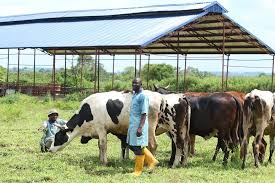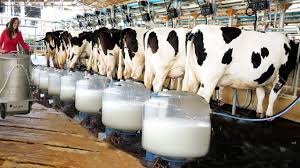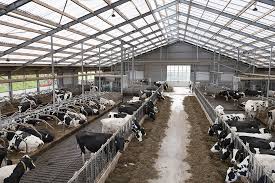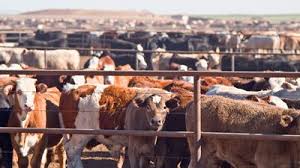Cattle farming plays a vital role in the global economy, impacting various sectors including agriculture, food production, industry, and even energy. This agricultural practice involves the breeding, raising, and managing of cattle primarily for meat (beef), milk, and hides.
However, the significance of cattle farming extends beyond food production to the livelihoods of millions around the world, particularly in rural areas.
With an estimated 1.5 billion cattle globally, the industry has a substantial influence on the agricultural economy, contributing to employment, food security, trade, and sustainable agricultural practices.
Cattle farming provides direct and indirect employment opportunities, especially in rural communities where alternative job opportunities are limited. Farmers, livestock handlers, veterinarians, feed suppliers, and transporters are just a few of the many roles associated with the industry.
In developing countries, where smallholder farmers are prominent, cattle farming serves as a primary source of income.
This income is not only essential for daily needs but also for improving the standard of living in these regions. Additionally, in many rural households, cattle are viewed as assets that can be sold in times of financial need, making them a critical part of local economies.
Cattle farming is vital for food security as it provides essential protein sources through beef and dairy products. Beef is a rich source of protein, iron, and other nutrients, while dairy products such as milk, cheese, and yogurt contribute to nutritional health worldwide.
In regions where malnutrition is prevalent, cattle farming helps bridge the gap by providing affordable sources of protein and essential nutrients.
Moreover, dairy farming, a branch of cattle farming, supports local economies through the production of fresh milk, which can be processed into a variety of dairy products, contributing to food diversity and nutritional balance.
Cattle farming contributes significantly to global trade, as beef, dairy products, and cattle by-products like leather are major exports for many countries. The demand for beef and dairy products has grown steadily, particularly in emerging economies with rising incomes, increasing urbanization, and changing dietary preferences.
Countries like Brazil, the United States, and Australia are some of the leading exporters of beef, while nations in the European Union and New Zealand are prominent dairy exporters.
This trade bolsters national economies, brings in foreign exchange, and strengthens the economic ties between exporting and importing nations.
Beyond meat and dairy, cattle farming also produces numerous by-products used in various industries. Leather, a valuable by-product, is used in fashion, furniture, and automotive industries, creating an additional revenue stream for cattle farmers. Other by-products such as gelatin, tallow, and pharmaceuticals have diverse applications, from food production to cosmetics and medicinal products.
Cattle manure is also widely used as a natural fertilizer, enhancing soil health and promoting sustainable agricultural practices. Some farms even convert manure into biogas, which can be used for energy, demonstrating cattle farming’s potential contribution to renewable energy.
While cattle farming has faced criticism due to concerns over greenhouse gas emissions and land use, it also offers opportunities for environmental sustainability when managed responsibly. Techniques like rotational grazing and the integration of silvopastoral systems can reduce the environmental impact of cattle farming.
Additionally, cattle farming can play a role in carbon sequestration, soil health improvement, and biodiversity preservation when sustainable practices are employed. This balance between productivity and sustainability is increasingly essential as the world seeks to meet its food demands while minimizing environmental harm.
Contribution of Cattle Farming to Rural Employment

Cattle farming supports rural communities by creating various job opportunities:
1. Direct Employment: Cattle farming directly employs farmers, herders, and ranch hands who manage daily operations such as feeding, milking, and general animal care.
2. Indirect Employment: The industry also creates jobs in sectors like veterinary services, feed supply, equipment manufacturing, and transport. These jobs support the functioning and sustainability of cattle farms.
3. Seasonal Employment: During peak times, such as calving and harvesting seasons, cattle farms often require additional labor, offering seasonal job opportunities in rural areas.
4. Skill Development: Cattle farming helps workers acquire skills in animal husbandry, farm management, and veterinary care, contributing to long-term employment prospects in agriculture.
5. Support for Family Farming: Cattle farming supports family-run operations, enabling multiple generations to work on and benefit from the farm. This structure helps maintain rural communities and supports local economies.
Cattle Farming and Income Generation
Cattle farming is a significant source of income for rural households, providing financial stability and economic growth:
1. Dairy Sales: Milk and other dairy products like cheese, butter, and yogurt provide consistent income for farmers. Many rural households rely on dairy sales as a primary income source.
2. Meat Production: Selling beef is another critical income stream. Cattle farming supports both small-scale and large-scale meat production, allowing farmers to tap into domestic and international markets.
3. Sale of By-products: Cattle farming generates by-products such as leather, bones, and manure, which can be sold to other industries, creating additional revenue.
4. Breeding Services: Farmers can also earn income by offering breeding services, such as selling semen or young breeding cattle to other farms, especially those seeking high-quality genetics.
5. Value-Added Products: Some farmers diversify by producing and selling value-added products, such as specialty cheeses or organic beef, which can command higher prices in niche markets.
Role of Cattle Farming in Food Production
Cattle farming is essential to food security and sustains the agricultural supply chain:
1. Dairy Products: Cattle farming is the primary source of milk and dairy products, which are vital sources of nutrition, providing protein, calcium, and vitamins necessary for healthy diets.
2. Meat Supply: Beef is a significant protein source in many diets worldwide. Cattle farming ensures a steady supply of meat, contributing to dietary diversity and nutrition.
3. Nutrient-Rich By-products: By-products from cattle, such as liver and bone marrow, provide additional nutrients. These can be crucial in regions where diets may lack variety.
4. Fertilizer Production: Manure from cattle is a valuable organic fertilizer. It supports crop farming by enriching the soil with essential nutrients, boosting food production.
5. Sustainable Food Systems: Cattle farming can contribute to a sustainable food system when managed responsibly. Practices like rotational grazing and manure recycling improve soil health, enhance water retention, and promote biodiversity.
Read Also: Hookworms: Description, Damages Caused, Control and Preventive Measures
Cattle Farming and the Dairy Industry

Cattle farming is a cornerstone of the dairy industry, significantly contributing to food production and economic stability:
1. Milk Production: Cattle are the primary source of milk, providing essential nutrients like calcium and protein. Dairy farming helps meet the global demand for milk and milk products.
2. Diverse Dairy Products: Cattle farming supports the production of various dairy products, including cheese, yogurt, butter, and ice cream. These products are staples in many diets and contribute to food diversity.
3. Employment Opportunities: The dairy industry creates jobs in farming, processing, distribution, and retail sectors. This leads to economic development in rural areas where cattle farming is prevalent.
4. Value Addition: Dairy farmers often process milk into higher-value products, allowing them to maximize their income. For example, making cheese or yogurt can significantly increase profit margins.
5. Nutritional Security: Dairy products from cattle farming play a crucial role in enhancing nutritional security. They provide essential vitamins and minerals, supporting healthy diets in many communities.
Impact of Cattle Farming on the Meat Industry
Cattle farming is also a significant driver of the meat industry, influencing both local economies and global markets:
1. Beef Production: Cattle are a primary source of beef, which is a major source of protein in many diets. Beef production supports local consumption and exports, contributing to food security.
2. Job Creation: The meat industry generates jobs in various sectors, including cattle raising, processing, distribution, and retail. This employment helps support rural economies.
3. Economic Growth: The meat industry contributes significantly to national and global economies. The sale of beef generates substantial revenue, supporting farmers and related businesses.
4. Export Markets: Many countries rely on cattle farming for beef exports, contributing to their trade balance. The demand for beef in international markets boosts local economies and encourages investment in cattle farming.
5. Sustainable Practices: With increasing demand for sustainable practices, cattle farming can adapt by focusing on ethical animal husbandry, reducing emissions, and ensuring the responsible use of resources.
By-products of Cattle Farming and Their Economic Value
Cattle farming produces valuable by-products that contribute to economic stability:
1. Leather Production: Cattle hides are processed into leather, which is used in fashion, upholstery, and various industries. Leather production adds significant value to the cattle farming process.
2. Fertilizers: Manure from cattle is a vital organic fertilizer that enriches soil health. It supports crop production and enhances food security, creating a circular economy in agricultural practices.
3. Bone Meal and Blood Meal: By-products like bone meal and blood meal are used as animal feed supplements. These products provide essential nutrients, promoting healthy livestock and reducing waste.
4. Gelatin Production: Cattle bones and connective tissues are processed into gelatin, which is used in food, pharmaceuticals, and cosmetics. This adds value to the cattle farming process and diversifies income streams.
5. Biogas Production: Manure can be used in biogas digesters to produce renewable energy. This sustainable practice reduces waste and provides an alternative energy source for farms and communities.
Read Also: Why Eggs Are Good For You – The Exceptional Super Food for Your Health
Cattle Farming and Global Trade

Cattle farming has a significant impact on global trade, influencing economies and markets worldwide:
1. International Beef Trade: Countries that produce beef, like the United States, Brazil, and Australia, export significant quantities. This trade contributes to national economies and food availability worldwide.
2. Trade Agreements: International trade agreements can affect cattle farming, impacting tariffs, trade barriers, and market access. Farmers must adapt to changing regulations and market demands.
3. Global Demand: As populations grow and diets evolve, the global demand for beef and dairy products continues to rise. Cattle farming plays a crucial role in meeting this demand through sustainable practices.
4. Economic Interdependence: Cattle farming fosters economic interdependence among countries, as regions specialize in specific products, creating a global supply chain that supports food security.
5. Market Access for Smallholder Farmers: Global trade can provide market access for smallholder farmers, allowing them to reach international buyers and improve their livelihoods through cattle farming.
Cattle Farming’s Contribution to Agricultural Sustainability
Cattle farming can contribute positively to agricultural sustainability in several ways:
1. Soil Health Improvement: Cattle manure serves as an organic fertilizer that enhances soil fertility and structure. This practice promotes healthy crop production and reduces the need for chemical fertilizers.
2. Biodiversity Support: Integrated cattle farming systems can support biodiversity by providing habitats for various species. Diverse agricultural landscapes help maintain ecological balance.
3. Carbon Sequestration: Properly managed cattle grazing can promote carbon sequestration in soils and pastures. This practice can help mitigate climate change by storing carbon in the ground.
4. Efficient Land Use: Cattle farming can utilize marginal lands that are unsuitable for crop production. This efficiency helps optimize land use while providing food and resources.
5. Sustainable Livelihoods: By providing income and employment opportunities, cattle farming supports the livelihoods of rural communities, contributing to social stability and economic development.
Economic Benefits of Cattle Farming in Developing Countries
Cattle farming offers numerous economic advantages, particularly in developing countries:
1. Poverty Alleviation: Cattle farming can be a significant source of income for smallholder farmers, helping lift them out of poverty and improving their standard of living.
2. Food Security: By providing meat and dairy products, cattle farming enhances food security in developing regions, ensuring access to essential nutrients.
3. Job Creation: The cattle farming sector generates employment in various areas, including farming, processing, transportation, and retail, contributing to economic growth.
4. Trade Opportunities: Many developing countries export cattle products, boosting their economies and providing access to international markets. This trade can generate foreign exchange and strengthen local industries.
5. Support for Other Sectors: Cattle farming can stimulate growth in related sectors, such as feed production, veterinary services, and agro-processing, creating a more robust agricultural economy.
Challenges Facing the Cattle Farming Industry
Despite its benefits, the cattle farming industry faces several challenges:
1. Climate Change: Changing weather patterns, extreme temperatures, and droughts can negatively impact cattle health and productivity, threatening food security.
2. Land Degradation: Overgrazing and improper land management can lead to soil degradation, reduced pasture quality, and loss of biodiversity, posing risks to sustainable farming.
3. Market Volatility: Price fluctuations in cattle products can create economic uncertainty for farmers, affecting their income and long-term planning.
4. Animal Health Issues: Disease outbreaks can severely impact cattle populations and productivity, necessitating effective veterinary care and biosecurity measures.
5. Regulatory Challenges: Farmers must navigate complex regulations related to environmental protection, animal welfare, and food safety, which can be burdensome and costly.
Future Prospects of Cattle Farming in the Global Economy
Looking ahead, cattle farming has the potential to adapt and thrive in the global economy:
1. Technological Advancements: Innovations in breeding, nutrition, and animal health can enhance productivity and sustainability in cattle farming, addressing some current challenges.
2. Sustainable Practices Adoption: Increasing consumer demand for sustainably produced food can drive cattle farmers to adopt environmentally friendly practices, improving market access and profitability.
3. Global Demand Growth: As the global population continues to rise, the demand for meat and dairy products is expected to increase, providing opportunities for cattle farming expansion.
4. Collaboration and Knowledge Sharing: Partnerships between farmers, researchers, and policymakers can foster knowledge exchange and promote best practices in cattle farming.
5. Investment in Infrastructure: Developing countries can benefit from investments in infrastructure, such as transportation and processing facilities, improving the efficiency and competitiveness of the cattle farming sector.
Do you have any questions, suggestions, or contributions? If so, please feel free to use the comment box below to share your thoughts. We also encourage you to kindly share this information with others who might benefit from it. Since we can’t reach everyone at once, we truly appreciate your help in spreading the word. Thank you so much for your support and for sharing!
Read Also: Complete Composting Guide for Beginners
Frequently Asked Questions
We will update this section soon.

